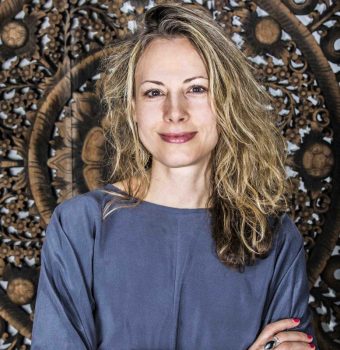
How a simple breathing technique cured my panic attacks
I was having several panic attacks a day during my postpartum depression, and was desperate to get a reprieve from the relentless insomnia, anxiety and panic. A simple breathing technique stopped my panic attacks in their tracks, and saved me from checking myself into a psychiatric hospital.
In a last ditch attempt to avoid hospitalisation, I saw a CBT therapist Dr. Robin Hart, who taught me a very simple breathing technique that I should start as soon as I felt a wave of panic. He recorded it on my phone, and over the next few days and weeks, I clung to that recording for dear life, and in turn, it changed my life.
It was amazingly simple: breathe in through the nose for 4 seconds; hold 4 seconds; breath out slowly through pursed lips for 8. Incredibly, it worked. Gradually, as I practiced this technique on a daily basis, I felt more and more confident that I had a reliable tool to control my panic, instead of it controlling me.
And sure enough, in the intervening ten years since, I have rarely had another panic attack, and when I feel anxiety rise, I practice this breathing technique and instead of growing into a full blown panic attack, the anxiety gradually dissipates.
Why is breathing so powerful? (apart from the fact that it keeps us alive!) 😉
Since then, I have learned more about the science of the breath, and why we have the capacity to calm ourselves with our breathing. I have learned that an exhale slows our heart rate down, sending the signal to our nervous system that we are safe; that increasing the amount of carbon dioxide in our blood through a longer exhale and a shorter inhale can paradoxically increase the uptake of oxygen into our cells; that deep belly breathing stimulates the vagus nerve and increases vagal tone, which helps restore balance to our nervous system.
There are other mechanisms at work as well, but suffice it to say, that the ancient yogis and meditators were really onto something with their emphasis on breathing techniques such as pranayama, realising that it was key to a sense of peace, but also vital to feeding our life force—prana or chi—which we all depend on to survive and thrive.
As Richie Bostock says in our interview “Exhale! The incredible power of breathwork for mental health and happiness” breathing is a tool, a Swiss army knife which can be used for many different purposes: to calm us down, rev us up, increase our feelings of happiness, help heal our trauma, and enhance sexual and spiritual experiences. The sum total of what we can do with breathing to alter our states of mind or consciousness is called “breathwork”.
Breathwork as therapy
I had a transformative experience of breathwork when I worked with Rebecca Dennis of “the Breathing Tree”. She used different breathing techniques to release stuck energy, stress and trauma in my body, which usually involved lying on the floor breathing in a certain way and crying uncontrollably due to some emotional release, coaxed out by Rebecca, telling me the entire time that I was safe in my body. Then, a feeling of exhaustion but also complete peace would sweep over me, and I felt somehow cleansed, happier and lighter.
It was a form of somatic therapy that didn’t involve much talking, and taught me to stay in my body and with my breath when rocked by difficult feelings. As such, it was sort of metaphor for life—that when we are ransacked by difficult emotions and situations, we should try to stay present, aware and embodied, so that we are more able to respond appropriately, and do what is best for our wellbeing in that moment.
I also did a very memorable and cathartic two day workshop in May 2019 with Rebecca, Jambo Truong and Michele Barrocci called “Journey to Being: through breath, movement and sound”, which brought me several deep spiritual insights, the likes of which I had had before intellectually, but rarely experienced in such an embodied and felt way.
The instructors took us on a journey of several hours of breathing and movement exercises, many of which involved us lying on the floor, each on a yoga mat, breathing heavily, and then descending into paroxysms of crying, screaming, pounding the floor, and generally letting out a lot of stress, anxiety, fear, trauma, and grief. Sounds like a fun weekend activity? Fun may not be the first word that springs to mind, but it was transformative.
As everyone was screaming and pounding the floor, I was overcome with the profound sense that we were all connected in our humanity, in our common pain and wounding. And yet I was also acutely aware that each of us had our own drama that we needed to process alone. That the screaming person next to me, in front of me, behind me, were in their own drama, as I was in mine, and that was OK.
I was very conscious that our bodies were our boundaries, and it became really important not to get sucked into the other person’s drama, but to stay in our own bodies. Just as it was important to stay in our own bodies while we experienced our own wounding; our bodies being the container for all this humanity with its inherent pain.
It drove home the importance of boundaries, figuratively and literally. The importance of processing our own stuff without getting distracted, blindsided or sidetrack by other peoples’ stuff, without needing the other to look at our own drama, judging or validating it.
Some insights from breathwork
No wonder we have a hard time with boundaries. We crave that feeling of fusion and connection which is our birth right, and yet ideally we come to it from a place of being fully grounded in our own reality, fully boundaried within and connected to ourselves first and foremost, before we can connect with others.
How do we navigate this dichotomy between the desire for fusional connection with others, and the need for firm boundaries and a developed and autonomous Self? The helpers who supported us throughout the weekend seemed to symbolise this by coming and going, holding us in our pain, because they themselves were resourced enough to be able to hold us, but then moved on and left us to it.
And maybe that is what it’s about – we need to be taught from the outside first, how to be held in our pain—as a good mother teaches a child how to manage difficult emotions. Once we integrate that, we can do it for ourselves. And then from the strength of being integrated and embodied within ourselves, we can hold and connect with others. We will realise more fully that we are always, and have always been connected with them; and that as resilient adults, if we can, we owe it to our fellow human to hold each other in our common humanity and pain.
We are all just walking each other home – Ram Das
